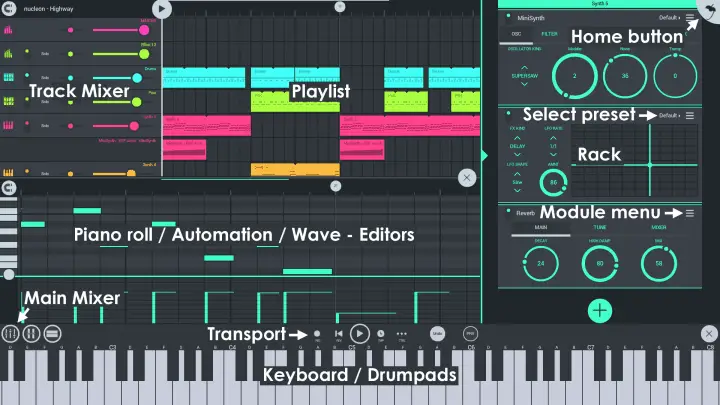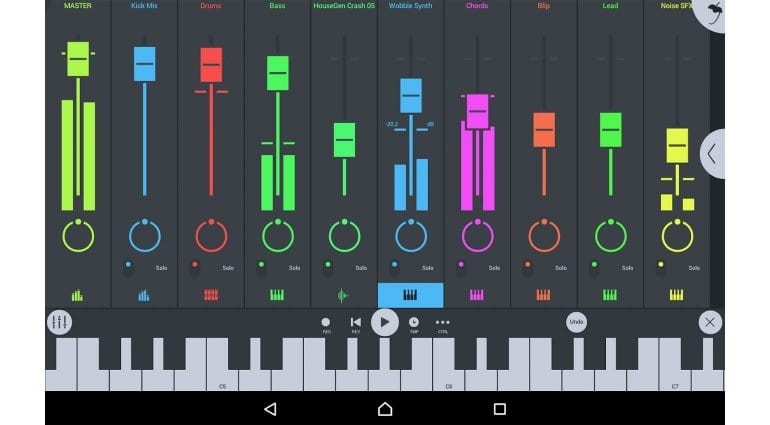Disclosure: When you buy through our links, we may get a commission at zero cost to you.
In this guide, I am going to show you how to import and export midi files in Fl Studio 12
Sometimes you will feel like using the MIDI data of one particular pattern for another project or the MIDI data you downloaded or perhaps, the ones your friend sent you.
FL Studio allows you to open one MIDI file at a time, using the the Import MIDI file option. If this file has multiple tracks the pop-up dialog will allow you to select and load these into separate Channels. If you want to load several MIDI files into separate Channels then please follow the procedure below. We designed this easy-to-follow guide to help you import MIDI files in FL Studio. We also have similar guides for using MIDI files in Ableton Live, Studio One, Logic Pro, and Cubase. This guide starts by outlining what a MIDI file is and how to use MIDI files & MIDI tracks. Then I will show you two ways of importing a MIDI file into FL Studio. Import project files downloaded for this tutorial into FL Studio. 4) Import all your samples into your channel rack as shown below; 5) layout all your kicks as shown below, make sure you have all 3 kick samples imported.

The easiest way of doing this is to import the MIDI file into your production session if downloaded or shared to you by a friend or perhaps, to re-import the melody if you plan on using it in another project.
Why Are Midi Files Useful?
MIDI files are useful if you want to reuse, send to other daws and other software as well.
Let’s Take a Look On How To Import a New Midi File Into Fl Studio
You should know the directory of the new MIDI file you want to import. Mine is located on my desktop.
Open Fl Studio > Goto FILE > Select import and click MIDI file, find the location of the MIDI file and click OK.
You’ll get a message telling you to import All tracks, click accept and your new MIDI files will be loaded unto Fl Studio, select OK.
If done correctly, you should be up and be running with those images below
Exporting Midi Files
Let’s take a look on how to export a MIDI file in Fl Studio, as you can see below, I have gotten a nice Chord progression.
To export a MIDI file, We can then use the basic main menu options in the piano roll to export the MIDI, and then re-import it in the new project. To do this, I go over to the main menu, click on File and Export as MIDI File.
Give it a name. I will be calling mine MIDI Exclusive, find the location you want to export your MIDI file and press Enter.
Using this method is an excellent way for collaborating with other producers. MIDI is a much more efficient way of sharing melody information than exporting audio files, so taking full advantage of this feature in FL Studio 12 will help you massively streamline your workflow.
Team Horlaes.
Useful Related posts:
When it comes to making beats in FL Studio, there are literally hundreds of ways to use samples!
In this tutorial, you’ll learn a simple way to start making sample-based beats.
But a warning:
This is just ONE way to sample in FL Studio.
There are plenty of other methods you can use, so feel free to cherry pick whatever works for you in this article.
Now let’s get started at the very beginning…
Before you continue reading…
This tutorial is a beginner’s guide and doesn’t cover how to pitch shift and time-stretch your samples
Click the button below to download the advanced guide for free.
Finding samples for your projects
Step one is to find songs or sounds you want to sample.
A great place to start is online.
There are plenty of online resources to find songs and loops to download for free.
But be careful if you plan to make beats for profit. Most of the sounds you find are prohibited by the copyright police.
So be cautious. Try searching for royalty free samples, loops and sound libraries.
Royalty free samples allow you to use the content without copyright infringement.
Sample libraries also contain higher quality audio files in wav format, occasionally labelled with tempo and key.
If you’re just practicing and have no intention of sharing your music, then sample whatever you want!
But if you’re looking to practice safe sampling, start with licensed sound libraries, sample packs and drum kits.

Once you’ve downloaded audio files you want to sample, it’s time to create a new FL Studio project.
How to import samples into FL Studio
Step two is to extract the section you want to sample.
To do this, we’ll use Edison to import the audio file.
Open Edison by clicking on its icon in the menu.
Next, import the audio file you downloaded in the previous step.
With the full audio file loaded into Edison, it’s time to start sampling.
Use Edison to play the audio file until you find a section of the song you want to sample.
Ideally, you want to find at least 4 bars of music that loop seamlessly.
Once you’ve found a loop, you can drag along the waveform to highlight it.
After you’ve highlighted the loop, you can send it to the Playlist.
How To Import Samples Fl Studio Mobile
How to find the tempo of a sample in FL Studio
Once the sample is in the Playlist, you’ll want to find its tempo.
Finding the tempo is essential. It helps you align the BPM of your project with your sample. This ensures that the elements in your beat are in rhythm.
Here’s how you find the tempo:
Start by aligning the sample with the start of the song in the Playlist. Then change your project tempo settings until the loop matches the bars of the grid.
This confirms that your project tempo is in sync with your sample.
Another way to find the BPM of your sample is to use FL Studio’s tempo detection feature.
Just right click the waveform icon in the top left corner of the audio file, and click on Detect tempo.
In the new dialog window that pops up, click the option with the widest range.
Then, the software will provide an estimated tempo of the sample.
But sometimes the result is wrong. Your best bet is to learn how to count beats using the first method.
Want 100% accuracy for the tempo?
Learn a little-known method for finding the tempo without using extra software…
Click the button below to download the advanced guide for free.
How to find the key of a sample in fl studio
After you’ve found the tempo, you may want to find the key.
This step requires some basic music theory, and is entirely optional.
To manually find the key of your sample, open a new instance of a simple instrument plugin, like FL Keys, in the channel rack.
Then listen to the loop, and play the notes on your piano roll that make up the chords of the music.
If you’re unsure what key makes up the notes, refer to a reference chart.
Now that you have the tempo (and key), you have a couple options:
Option #1 is to use the loop as the foundation of your beat.
Option #2 is to chop the loop to create a new pattern.
Let’s discuss both…
How to loop samples in FL Studio
How To Import Samples Into Mac Fl Studio Mobile Home
If you’re satisfied with the loop as it stands, you can repeat it throughout your track.
To loop your samples, use the Paint tool to add new instances of the loop in the Playlist, as many times as you want.
Quick tip:
If you plan to customize the loops, you’ll want to make each sample unique.
Otherwise, you’ll end up changing ALL the loops in your track.
How to chop samples in FL Studio
If you prefer to chop your loops, you’ll want to use a sampler instrument.
Using a sampler, you can split your loops into sections and arrange them into new patterns.
For this tutorial, we’re going to use Fruity Slicer.
Other tools, like Slicex and various third party samplers, offer more advanced customization. But that’s beyond the scope of this tutorial…
So what’s the difference between Fruity Slicer and Slicex, you ask?
Here’s a simple answer:
Slicex is a sampler instrument AND an audio editor. This makes it great for customizing each slice and sampling drum loops.
Fruity Slicer is just a sampler instrument, and is simpler to use.
So for now, let’s return to Fruity Slicer to keep things simple…
First, open a new instance of Fruity Slicer in your sequencer.
Next, load the sample by clicking on the sample button, and choosing “load sample”. Navigate to the audio file you want to import.
Once you load the sample, change the tempo of Fruity Slicer to the tempo of the sample.
Now it’s time to chop the sample.
Click the slicing button and choose from the incremental options.
I recommend you choose “Beat” as your slicing option for the best results.
You can choose to slice by fractions if you prefer, but using more slices will add complexity later.
At this stage, you should have your samples loaded and key mapped to your midi keyboard (if you’re using one).
Now you can use Fruity Slicer like any other virtual instrument to make your own patterns.
Draw the notes into your piano roll to find a pattern that fits your beat.
Or play the samples on your midi keyboard while recording into FL Studio.
Experiment with your samples to put your beat together.
Since sampling is the focus of this tutorial, we’re going to skip the part where you add to your beat.
This is where you would enhance your arrangement with bass, drums, one-shot vocal samples, sound FX, etc.
So let’s move on to step 3 for some tips on improving your sample-based beats.
Want more control over your slices?
Learn this simple method to manually slice your samples for Fruity Slicer…
Click the button below to download the advanced guide for free.
Tips for improving your samples

After you’ve set the foundation for your arrangement, you can customize your samples in the mixer.
Tip #1: Make room for the low end
Oftentimes your samples will include elements that detract from the overall mix.
This can lead to tracks that sound busy.
Your best bet is to use EQ to remove unnecessary elements.
But be careful when removing frequencies. Dynamic range is essential in music.
Tip #2: Customize the character of your samples
You might want to add mixing effects to change the feel of the sample.
For example, you can apply reverb, echo or time stretching effects to alter the sample.
There are also plenty of advanced techniques to help you create unique versions of your samples, which we’ll explore later.
Tip #3: Create your own mixing presets.
Once you’ve experimented with enough plugins, you’ll find particular settings that you like.
Be sure to save your favorite configurations as presets.
As you work, create new mixing channels for your samples, and save your configurations.
Congrats on making it this far!
Have fun sampling, and hit us up if you have any questions.
Comments are closed.